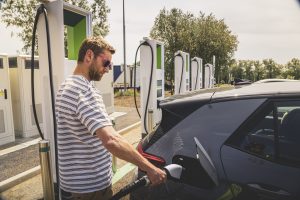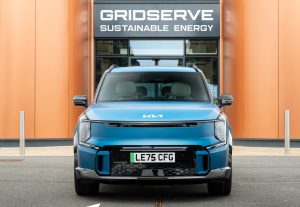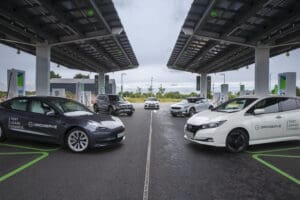

The era of electric cars brings more than just clean travel, it opens up a world of connected and smart technology.
The move from big, noisy petrol and diesel engines to electric motors and batteries brings with it a new generation of clever software that can make travel more efficiency and more sustainable than ever before.
One of those is vehicle-to-grid technology, or V2G for short.
This enables you to use the energy stored in your battery to not only power your vehicle but also balance demand on the grid when you’re not using it.
Let’s take a deeper drive into how V2G technology works, the benefits to you and how it can help power the future.
What is vehicle-to-grid (V2G) technology?
When you plug into a charger – whether at home or on-the-go on the GRIDSERVE Electric Highway – you’re drawing electricity from the grid into your battery.
This energy is then stored in the battery to be used as you drive to the supermarket, pick the kids up from school or go on a holiday road trip.
It’s the same basic concept as filling up your tank with petrol or diesel. However, unlike regular fuel, the energy can also flow back into the grid with something known as bidirectional charging.
This effectively allows you to turn your EV into a mobile storage unit – a bit like a power bank you might use for your smartphone.
Plug in at home and charge up the battery when electricity is cheap and then discharge it back into the grid to support demand or even power your home in an emergency.
Benefits of V2G for EV owners and the grid
The capability of V2G technology has been around for a number of years, but it’s only in the last couple of years that it’s starting to be used more commonly, although the UK is not quite ready to deploy it in full.
That said, it’s no longer just a cool party trick but has some real-world benefits for EV owners and the energy business as a whole
Lower Electricity Costs
The price of electricity fluctuates throughout the day with the cost peaking during the most in-demand hours of 4pm and 8pm.
If you’ve charged your vehicle overnight using a smart tariff when electricity is cheaper, you could then discharge the energy stored in your battery back into the grid at peak times and earn credits or money off your energy bill.
We’re starting to see the first energy tariffs available that hint at making this possible, with more expected as the energy infrastructure in the UK adapt to V2G.
Grid stablisation and peak load management
Sending energy back into the grid at peak times offers not only a financial benefit for EV owners but also huge opportunities to support the National Grid.
If the grid could rely on a surplus amount of energy to call upon when it needs it, millions of pounds a year could be saved a year.
Currently, a large amount of money is spent keeping power stations and wind turbines running during low demand times so they’re ready to generate electricity when everyone turns their kettle on at half time in the football.
If the energy was already created and ready to go, the grid would be able to better optimise load management.
Some experts predict smart energy systems such as V2G could save up to £40 billion by 2050.
Challenges of V2G
There are a number of hurdles that need to be overcome to harness the true power of V2G as part of a wider smart city ecosystem.
Widespread adoption requires a standardised communication protocol between car and energy infrastructure, affordable compatible chargers and smart grid infrastructure.
Once these are in place, we’ll see a range of energy tariffs introduced that support V2G technology, and that encourage people to invest in both vehicle and charger to reap the rewards.
There also remains a question mark over whether V2G technology will impact battery degradation.
Using bidirectional V2G technology will increase the number of charging and discharging cycles that the EV battery is subjected to.
However, studies suggest the impact can be minimised when managed by smart battery management software.
How to get started with V2G technology
We said earlier that V2G technology is growing in popularity but the UK is not quite there… yet.
To be prepared, you’ll need to have a compatible vehicle and home charger that supports bidirectional charging.
Not all EVs currently offer it, although in Japan it’s now a mandated law with the Nissan LEAF one of the early pioneers of the technology.
Expect V2G to become standard on new models released in the next few years, as well as offered as over-the-air software upgrades on existing vehicles.
Once all the parts are in place, V2G has the potential to reshape energy usage across the world, making it more stable, greener and cheaper.
Another reason that the transition to EVs is more than just switching petrol or electricity.






